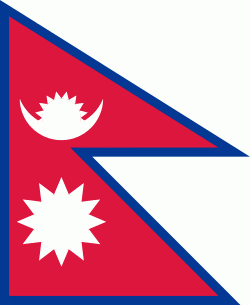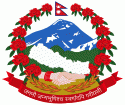Janakpurdham (Janakpur)
Janakpurdham or Janakpur (जनकपुर, ) is a sub-metropolitan city in Dhanusha District, Madhesh Province, Nepal. The city is a hub for religious and cultural tourism. A headquarter of Dhanusha district, Janakpur is also the capital for Madhesh Province.
The city was founded in the early 12th century. According to tradition and an Archeological evidence found at the site }}, ancient civilization indicates Janakpurdham as the capital of the Videha dynasty that ruled the Mithila region in ancient times.
Janakpur is located about 225 km southeast of Kathmandu. , the city had a population of 173,924. The city had a population of 195,438 in 2021. Janakpur is currently the most populated sub metropolitan city of Nepal. Janakpur is located about 18 km away from the Bhitthamore border of India. Nepal Railways operates between Janakpur and Jaynagar of India.
Accounts from ascetics, pandits, and bards indicate that Janakpur was founded in the early 18th century. The earliest description of Janakpur as a pilgrimage site dates to 1805. Earlier archaeological evidence of the presence of an ancient city has not been found. King Janaka's palace is thought to have been located in ancient Janakpur as it is believed to be the capital of the Kingdom of the Videhas. According to Ramayana, he found a baby girl in a furrow, named her Sita, and raised her as his daughter. When she was older, he offered her in marriage to anyone who was able to lift the bow of Shiva, left near Janakpur a thousand years earlier. Many royal suitors tried but only Rama, the prince of Ayodhya, could lift the bow. According to an old song, this bow was found northeast of Janakpur.
Until the 1950s, Janakpur was a cluster of rural hamlets inhabited by farmers, artisans, priests, and clerks who worked for the monasteries that controlled the land. After the Independence Act in India, Janakpur expanded into a commercial center and became the capital of the Dhanusa District in the 1960s.
As Rama and Sita are major figures in Hinduism, Janakpur is an important pilgrimage site for Hindus. According to the first millennium BC text, Shatapatha Brahmana, the Maithil king Videgha Māthava crossed the Sadānirā (Gandaki River), led by his priest Gotama Rahugana, and founded the Kingdom of Videha with Janakpur as the capital city. As Gotama Rahugana composed many hymns of the Rigveda, these events must date to the Regvedic period.
Gautama Buddha and Vardhamana Mahavira, the 24th and final Tirthankara of the Jain religion are said to have lived in Janakpur. The region was an important center for the history of Mithila during the first millennium.
The city was founded in the early 12th century. According to tradition and an Archeological evidence found at the site }}, ancient civilization indicates Janakpurdham as the capital of the Videha dynasty that ruled the Mithila region in ancient times.
Janakpur is located about 225 km southeast of Kathmandu. , the city had a population of 173,924. The city had a population of 195,438 in 2021. Janakpur is currently the most populated sub metropolitan city of Nepal. Janakpur is located about 18 km away from the Bhitthamore border of India. Nepal Railways operates between Janakpur and Jaynagar of India.
Accounts from ascetics, pandits, and bards indicate that Janakpur was founded in the early 18th century. The earliest description of Janakpur as a pilgrimage site dates to 1805. Earlier archaeological evidence of the presence of an ancient city has not been found. King Janaka's palace is thought to have been located in ancient Janakpur as it is believed to be the capital of the Kingdom of the Videhas. According to Ramayana, he found a baby girl in a furrow, named her Sita, and raised her as his daughter. When she was older, he offered her in marriage to anyone who was able to lift the bow of Shiva, left near Janakpur a thousand years earlier. Many royal suitors tried but only Rama, the prince of Ayodhya, could lift the bow. According to an old song, this bow was found northeast of Janakpur.
Until the 1950s, Janakpur was a cluster of rural hamlets inhabited by farmers, artisans, priests, and clerks who worked for the monasteries that controlled the land. After the Independence Act in India, Janakpur expanded into a commercial center and became the capital of the Dhanusa District in the 1960s.
As Rama and Sita are major figures in Hinduism, Janakpur is an important pilgrimage site for Hindus. According to the first millennium BC text, Shatapatha Brahmana, the Maithil king Videgha Māthava crossed the Sadānirā (Gandaki River), led by his priest Gotama Rahugana, and founded the Kingdom of Videha with Janakpur as the capital city. As Gotama Rahugana composed many hymns of the Rigveda, these events must date to the Regvedic period.
Gautama Buddha and Vardhamana Mahavira, the 24th and final Tirthankara of the Jain religion are said to have lived in Janakpur. The region was an important center for the history of Mithila during the first millennium.
Map - Janakpurdham (Janakpur)
Map
Country - Nepal
 |
 |
| Flag of Nepal | |
The name "Nepal" is first recorded in texts from the Vedic period of the Indian subcontinent, the era in ancient Nepal when Hinduism was founded, the predominant religion of the country. In the middle of the first millennium BC, Gautama Buddha, the founder of Buddhism, was born in Lumbini in southern Nepal. Parts of northern Nepal were intertwined with the culture of Tibet. The centrally located Kathmandu Valley is intertwined with the culture of Indo-Aryans, and was the seat of the prosperous Newar confederacy known as Nepal Mandala. The Himalayan branch of the ancient Silk Road was dominated by the valley's traders. The cosmopolitan region developed distinct traditional art and architecture. By the 18th century, the Gorkha Kingdom achieved the unification of Nepal. The Shah dynasty established the Kingdom of Nepal and later formed an alliance with the British Empire, under its Rana dynasty of premiers. The country was never colonised but served as a buffer state between Imperial China and British India. Parliamentary democracy was introduced in 1951 but was twice suspended by Nepalese monarchs, in 1960 and 2005. The Nepalese Civil War in the 1990s and early 2000s resulted in the establishment of a secular republic in 2008, ending the world's last Hindu monarchy.
Currency / Language
| ISO | Currency | Symbol | Significant figures |
|---|---|---|---|
| NPR | Nepalese rupee | ₨ | 2 |
| ISO | Language |
|---|---|
| EN | English language |
| NE | Nepali language |















